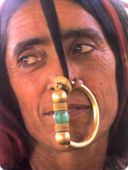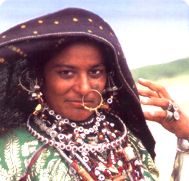|
Rabari people are a mystery of Kutch. Their lifestyle is completely different from any other tribe. North-west India has many castes of the Rabaris which are simply divided in three tribes in Kutch: Desi Rabaris, Dhebariya Rabaris and Vagadiya Rabaris. Desi Rabari live in the central and western sides of Kutch, Dhebariya Rabaris mainly live near Anjar Taluka and Vagadiya Rabaris live in the village named Vagad situated in the eastern side of Kutch. The story of their origin is likely related with Lord Shiva doing self mortification in Himalayas. The Rabaris move from one village to another by throwing away their house hold materials and small kids on a reverse bedstead kept on camels' backs.

It is said that Rabaris originally came from Jaisalmer of Rajasthan just like Mewar. As stated by an expert, Rabaris came to Kutch from Afghanistan through Baluchistan. But, some people still believe that they came from Sindh. Rabaris are expert camel breeders, cattle herders and shepherds. They are normally Hindus.
There are about 2500 to 3000 Rabari families in Kutch. Population of the Dhebariyas is the biggest population of Rabaris in Kutch. Midialo of Anjar Taluka is the main village of Dhebariyas and almost 800 Rabari families live in this small village.

A Rabari man commonly appears in the white dress with a white turban on his head or handkerchief of Kathi Ajarakh, a white full Abho, chorni like charsa, Ajarakh kerchief on shoulders, golden ear-rings and a big stick in one hand and Rabari women normally wear backless blouses with Odhanis.
Rabari men respect women. Men stay mostly in the desert the whole day with their sheep and camels. Women are normally busy in house work, shopping and selling their goods. Rabari women also do interesting embroidery of toran, thela, popat, blouse, gagra and decoration for the camels. Some of the women do the bead work.

Rabari people always keep their houses neat and clean. They decorate their houses with cow dung in which they make different and colourful designs of Putli, Paniari, Scorpio, Nag, Camel, Mor, Mango, Tree, Sudo and Kanudo. Their houses are spotless and normally Rabaris are found in groups.
Rabaris believe that the colour black is a symbol of sadness. Rabaris are almost illiterate and they have blind faith in religion. Bhopas are the chief of Rabaris. Rabaris love the nature much. They worship Mataji, Sikotara, Momaya, Loladi, Bhed, Vankol, Amba, Khodiyar, Hingalaj etc. There is an important journey called Hingalaj Yatra to all Rabaris. Usually, all Rabaris go to their holy places by foot. If someone of them dies on the way to the holy places, then they make a memorial stone with his name in his native village. Rabaris never trust doctors and they only use the Ayurvedic medicines.
Desi Rabaris are the oldest community of Rabaris in Kutch. They raise crops in addition to keeping herds of camels, buffaloes and sheep. Vagadiya Rabaris depend on herds of sheep, goats and camels for their lives.
All marriages of the Rabaris are still celebrated on only one day; Lord Krishna's birthday. In the recent years, a Kutchi Rabari group of women joined Kutch Mahila Vikas Sangathan (KMVS).
|